#How to make labels in microsoft word for mac 2011
Explore tagged Tumblr posts
Text
How to make labels in microsoft word for mac 2011

How to make labels in microsoft word for mac 2011 how to#
How to make labels in microsoft word for mac 2011 code#
How to make labels in microsoft word for mac 2011 download#
Then, after you burn your data, music, or video onto a CD or DVD, simply flip the disc over, put it back into the drive, and burn your newly created (laser-etched) label design directly onto the disc.
How to make labels in microsoft word for mac 2011 download#
With LightScribe, you create or download the label of your choice. If you’ll be hanging your mobile indoors, you could use tempera paint for this project.How do you burn labels on a LightScribe CD? Paint your CDs We chose acrylic paints because they hold up well for an outdoor project and also because the colours are rich and the coverage is great. The RW stands for rewritable because you can use it just like you would a floppy disk or hard drive and write data onto it numerous times. A CD-RW is a type of CD that allows you to burn over previously recorded data. Use your CD-RW discs over and over again. a hard disk drive) Can you write over a CD? Direct-to-disk recording (DDR), a recording method by which audio and/or video signals are recorded directly to digital storage media (e.g. What is direct disc printing?ĭirect-to-disc printing, the means by which an inkjet printable DVD has a label printed directly onto its surface with a specially-designed inkjet printer. After printing on a CD/DVD, carefully remove the CD/DVD from the CD/DVD tray, and then press the CD Tray button to close the tray. Make sure None is selected as Print Check Pattern setting and click Print. Select CD/DVD or CD/DVD Premium Surface as the Media Type setting. Select your printer from the printer list. Other markers may also work fine, but some may not.
How to make labels in microsoft word for mac 2011 how to#
And yes, you can ruin the disc and maybe the drive when you do that – here’s how to make it work.
How to make labels in microsoft word for mac 2011 code#
If you have a compatible template code select “Change document layout”, then click “Label options”. All you have to do is select one of the templates, fill it with your data and print the label. Microsoft Word 2007 is able to print CD labels and, in fact, comes with its own predefined CD label templates. Does Microsoft Word have a CD label template? Don’t worry about the design on the cover. Select the one that best suits the kind of cover you want to make. Select the “Template” option and click on “Labels.” In the “Media” category, browse the CD cover templates available. Open Word and choose “New” from the “File” menu.
36 How to make labels in Word | Microsoft Word tutorial.
35 How to design a DVD label in Microsoft Word 2016.
32 How do you burn labels on a LightScribe CD?.
31 What kind of paint can you use on CDs?.
27 Can you write on a CD with a Sharpie?.
25 How do I make labels in Word from Excel?.
24 What is the best way to make address labels?.
22 How do I print Avery labels with different addresses in Word?.
21 How do I use Avery 5266 labels in Word?.
17 Does Microsoft have a label template?.
16 How do I create labels in Word 2016?.
10 How do I download a label template in Word?.
9 How do I create avery 5160 template in Word?.
8 How do I create Avery 5162 labels in Word?.
7 How do you make a CD label in Word 2013?.
6 Where do I find label templates in Word?.
3 How do I create Avery CD labels in Word?.
First click on Create New which will reveal a drop down menu. Once youre in Word, if the 'Mail Merge Manager' doesnt appear, select it under the 'Tools' menu. You should specify that you want to merge to 'Mailing Labels'.
2 Does Microsoft Word have a CD label template? Under the 'Tools' menu, click on 'Microsoft Word:mac', then 'Create Mail Merge'.
1 How To Make Cd Labels On Microsoft Word?.
Use the Microsoft Word's Find and Replace formatting tool to replace all the pre-designed template text in each label with your own information.
Continue with Step 3 until all labels are filled with your information.
Position the cursor in the next label, right-click and select Paste.
Highlight all the content in the first label, right-click and select Copy.
Insert your information on the 1st label.
How to create a sheet of all the same labels: Then click Text Wrapping and select In Front of Text in the drop down list. Select your image in the template and click the Page Layout tab in the Ribbon Toolbar. Highlight the text you entered and use the tools in Microsoft Word to format the text.Ĭlick the Insert tab in the Ribbon Toolbar to insert your own image, clip art, shapes and more. Once the file is open, type your information into the template. If the template looks like a blank page, select Table Tools > Layout > Show Gridlines to view the template layout. Double-click the Avery Word Template file you downloaded and saved to your copmuter.

0 notes
Text
How to make address labels in word for mac 2011

#HOW TO MAKE ADDRESS LABELS IN WORD FOR MAC 2011 PC#
#HOW TO MAKE ADDRESS LABELS IN WORD FOR MAC 2011 FREE#
Using the Photo URL to Produce Name Tags and Badges … If you’re looking to make customized labels, look no further than Microsoft Word. Select the “Mailings” tab and click “Start Mail Merge” in the Start Mail (15)… Step 2: Open the Name Tag Template in Microsoft Word.Microsoft built a powerful Mail Merge feature into Microsoft Word that can pull in records from any Excel spreadsheet and generate labels. 1) Why is the Word document blank when the name badge template (12)….Please note that these FAQs are answered specifically for creating nametags in Microsoft Word.
#HOW TO MAKE ADDRESS LABELS IN WORD FOR MAC 2011 FREE#
(10)…ĭownload free templates for name tags and badges for your next event! Use Avery Design & Print Online to quickly create hundreds of custom name tags. Create printable name tags with this easy-to-use Word template for name tags. The name badge labels in this template are 3″ x 2″. Microsoft Word recognizes a variety of commercial.5 pages (9)…
#HOW TO MAKE ADDRESS LABELS IN WORD FOR MAC 2011 PC#
Microsoft Office 2007/2010 on a PC computer used appropriately you are ready to make nametags. If you want to print only one label, select Single label in the Print box and specify the row and column where the label is located on the sheet.
3 min1.Click the Mailings tab.2.Click the Labels button.3.Enter an address.
If so, did you know that your Microsoft Office Word has its own label wizard app, Create an Account 3) Type a name for your labels, then click Save. How to Create Mailing Labels in Word – Worldlabel In the latest versions, including version 2013, you can import document templates such as a name tag template to quickly create a large number of name tags (6)… 3. If you’re designing your name tags in Microsoft Word, read It pulls information from a list of data then inserts it into your document/design. How to use MS Word to create name badges – The Faulty …Īs usual i was creating my name badges in MS Word (old school i know) but as i don’t have access currently to a mac with handy design tools on (4)… How To Get Microsoft Office Back After Factory Reset? 2.

1 note
·
View note
Text
Download Microsoft Word Algorithm Template Free

Access Free Microsoft Word Templates. Use the instructions below to find your label template and get started designing, creating, and printing all types of labels. Download blank label templates for Microsoft Word. For every label configuration we offer, there is a corresponding Microsoft Word template. Double-click the Avery Word Template file you downloaded and saved to your copmuter. If the template looks like a blank page, select Table Tools Layout Show Gridlines to view the template layout. Once the file is open, type your information into the template. Highlight the text you entered and use the tools in Microsoft Word to format the text.
Download Free Templates
Easily search for your template by product category and then choose from one of our a professional designs or blank templates to customize within Word.
Find a Template
Microsoft offers a wide variety of Word templates for free and with no hassle. Whether you’re planning a holiday party, in charge of the school newsletter, or want a matching resume and cover letter combination, you can find templates for Word that fit your needs. Studies website of ireland. Description: TheTemplateWizard presents professionally designed Algorithm Word template for your documentation and print purpose. This Algorithm word document template is affordable and easy to use and it lets you edit text easily and hassle free. Our Algorithm word doc template design is used by business, marketing, medical and many education professionals to give attractive look to their. Download All 3,440 “word” print templates unlimited times with a single Envato Elements subscription. All from independent designers.
Printing Tips for Microsoft Word
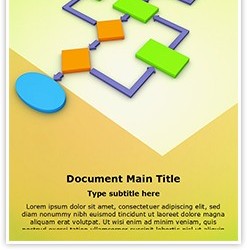
Here's how to be sure your product, page settings and printer settings can help you get the best print results.
Learn how
If you have Word 2007 or a newer version, follow the instructions below to find Avery templates built in to Microsoft® Word. Note: Older versions of Word are slightly different.
With your Word document open, go to the top of screen and click Mailings > Labels > Options. (In older versions of Word, the Options setting is located in Tools at the top of the page.)
Select Avery US Letter from the drop-down menu next to Label Vendors. Then scroll to find your Avery product number and click OK.
If you want all your labels to have the same information, type it into the address box and click New Document. If you want different information on each label, click New Document and then proceed to fill in your labels.
If your template looks like a blank page, select Layout > View Gridlines to see the template layout.
If your product number isn't built in to your software, you can download the template instead.
If you're working in Microsoft Word and your gridlines disappeared, you may need to enable the gridlines in order to see your actual card or label cells. If the template looks like a blank page, select Table Tools > Layout > Show Gridlines to view the template layout.
If you use Microsoft Office 2011 on a Mac computer, you can easily import addresses or other data from an Excel spreadsheet or from your Apple Contacts and add them to Avery Labels, Name Badges, Name Tags or other products. The Mail Merge Manager built into Microsoft Word for Mac makes it easy to import, then edit and print. These steps will show you how to mail merge onto an Avery template, making it easy to prepare for mailings and meetings.
If you use Microsoft Office 2016 on a Mac computer, you can easily import addresses or other data from an Excel spreadsheet or from your Apple Contacts and add them to Avery Labels, Name Badges, Name Tags, or other products to edit and print using Microsoft Word for Mac. These steps will show you how to mail merge onto an Avery template, making it easy to prepare for mailings and meetings.
Find your saved Microsoft Word file on your computer. Double-click the file to open it in Microsoft Word.
Open Microsoft Word and browse your computer for the saved document.
Double-click the Avery Word Template file you downloaded and saved to your copmuter. If the template looks like a blank page, select Table Tools > Layout > Show Gridlines to view the template layout.
Once the file is open, type your information into the template. Highlight the text you entered and use the tools in Microsoft Word to format the text.
Click the Insert tab in the Ribbon Toolbar to insert your own image, clip art, shapes and more.
Daily Assignments World History A.P. World History Daily Assignments. Below are the daily assignments for U.S. History & APUSH If you are absent you are to reference the page for the assignment/materials you missed. They are due the day after your return. August 14th/15th, 2017. World history assignment 1.02. World History Daily Lessons and Assignments. World History Periods 2-3, 5. Google Classroom Codes. Period Two: vmsygvu. Period Three: vapfi5q. Period Five: ufuqvbv. Semester One 2020. We will begin the Fall, 2020 Semester with Distance Learning that will begin on August 10th. Required content and lessons will be assigned through Google. This blog is a daily summary of our class activities and assignments. It is your responsibility to find out what you missed when you are absent from class, and this blog will help you do that. I will update the blog daily. It is my expectation that YOU will check it on days that you are absent.
Select your image in the template and click the Page Layout tab in the Ribbon Toolbar. Then click Text Wrapping and select In Front of Text in the drop down list.
How to create a sheet of all the same labels:
Blank Templates
Insert your information on the 1st label.
Highlight all the content in the first label, right-click and select Copy
Position the cursor in the next label, right-click and select Paste.
Continue with Step 3 until all labels are filled with your information.
Pre-Designed Templates:
Use the Microsoft Word's Find and Replace formatting tool to replace all the pre-designed template text in each label with your own information.
Download Microsoft Word Algorithm Template Free Word
Watch the video below to see how easy it is to do a mail merge in Microsoft Word.
The fastest way to download an Avery template is to go to avery.com/templates and type your Avery product or template number into the white Search Bar at the top center of the page. (Your product or template number can be found on the bottom right of your Avery packaging). You can also search by product category if you don't have your product or template number handy.
Once you've located your product, scroll down to the middle of the page to Download Templates. Select your preferred software from the drop-down menu and click Download Blank Template.
Note: Many Avery products have similar layouts but are different sizes, so make sure you use the correct template for your product. Imperialismmr volkmars course pages. It's also important to be sure you're using the correct product type for your printer. (Inkjet-only products should only be used in inkjet printers, and laser-only products in laser printers).
Feed me fractions. See the tips and tricks for adding and editing text and pictures, clip art and other images in Avery templates for Microsoft® Word.
Avery Design & Print
Word 2010 Templates Free Downloads
Create custom labels, cards and more using our free, easy-to-use design tool.

0 notes
Text
Pogue's holiday picks: 8 cool, surprising tech gifts
yahoo
The holiday season is the lifeblood of the tech industry. About 70% of U.S. consumers will buy tech stuff as gifts this holiday season, spending an average of $478 each, according to the Consumer Tech Association.
Most of that stuff is predictable: laptops, tablets, phones, Amazon (AMZN) Echos. OK, we get it.
But what if your lucky recipient already has that stuff, doesn’t want it, or doesn’t deserve an expenditure that big?
That’s where these more offbeat tech gift ideas come in. They join my earlier list of ideas for less expensive (but still surprising) gifts.
ConnectSense Smart Outlet $60
You’ve heard of the Internet of Things, right? It’s those gadgets that you can control with a phone app. You know—thermostats, light bulbs, door locks.
But if you get an Internet of Things outlet, you can control anything from your phone. Anything you plug in: lamp, heater, fan, radio, TV, Christmas lights, whatever.
There are lots of these “smart outlets.” But I’m a particular fan of the ConnectSense Smart Outlet ($60), because it’s compatible with Apple’s (AAPL) HomeKit. First, that means an incredibly easy setup: Open the ConnectSense app, point your phone’s camera at the sticker on the outlet, and boom—the device is recognized and configured.

You can control either outlet from an app, by voice, or from miles away.
HomeKit also means that you can turn the outlets on and off remotely, either from your phone’s Control Center (you don’t have to open some app first) or by voice. You can say, “Hey Siri—turn on the Christmas tree” [or whatever you’ve named that outlet] or “Hey Siri—turn on the Table Lamp!”
It just works.
You can also set up schedules for these on-and-off-turnings, or (if you have an Apple TV) even control it from across the internet. The app tells you how much energy each formerly dumb device has consumed.
Then again, if you’re not an Apple person, you might prefer the Wemo Mini Smart Plug; it lets you voice-control your outlet using Alexa or “OK Google” commands. It’s only $34, although it has only one outlet.
Logitech Craft Keyboard
You wouldn’t think there’s much call for PC peripherals anymore. Those were the hot items during the holidays maybe 20 years ago—but now? Who’d want a mouse or keyboard for Christmas?
You might, if you could try the Logitech Craft Keyboard for Mac or Windows (MSFT). It feels like it’s made of stealth-bomber carbon-fiber or something. It’s fully wireless, super thin, super sturdy, with a great typing feel and a complete set of keys, including a numeric keypad.
The best part, though, is the knob at top left, called the Crown. It’s an input device that works in three ways: You can turn it, you can tap it, and you can click it down—and in many programs, you can program what those things do!
You might set it up so that in most apps, turning it controls volume; tapping it means Play/Pause music; and pressing it switches apps. In Photoshop, you can have it change brush sizes. In a web browser, turning it might switch among open tabs.

It’s a great keyboard—with a knob.
Sadly, those customizable functions are available only in Microsoft Office and Adobe programs like Photoshop, Illustrator, and Premiere—not any program you want. I’d love for that knob to scroll the timeline in Final Cut, for example. Still, this keyboard transforms the experience of typing and doing creative work. The computer nerd in your life will adore it.
ReMarkable Tablet
What a weird, wonderful product!
The ReMarkable tablet, born as a Kickstarter success story, is true to its name. It’s pretty remarkable, and you can mark it over and over again.
It feels like a legal pad: very light, easily one-handable. You use the included stylus to write on it. (The stylus never needs batteries or charging.) There’s no lag when you write, and the grayscale E-Ink screen has no glass (the company says that the tablet is “virtually indestructible”); it’s a finely textured plastic, so it feels exactly like you’re writing on paper.

The ReMarkable is like a Kindle that you can write or draw on.
You can have your “paper” be blank, lined, or equipped with a grid, like graph paper. You can import PDF documents and mark them up, easy as pie—incredible if you’re a teacher or a lawyer or something.
And in real time, anything you write or draw on the tablet shows up on your computer, ready for sharing or printing. It’s all automatic and wireless.
I recognize that upon hearing the $600 price, a natural reaction might be, “Holy moly—for that money, you could buy an older iPad or Android tablet! Which is color, and has speakers and microphone and a backlight!”
And that’s all true. On the other hand, the comparison isn’t quite right. This thing isn’t a full-blown computer with a complex operating system and millions of apps. It’s simple, true to function, and an absolute joy to use. There’s really nothing else like it.
EvaLight Personal Air Conditioner
This little box, from Evapolar, sits on your desk and cools you much more effectively than a simple fan; it’s an actual personal air conditioner. It can’t chill an entire room; it creates a cocoon of cool only around you, using a tiny fraction as much energy (10 watts) as a regular air conditioner (900 watts).

It’s a personal air conditioner for your desk.
Now, the science of this thing makes no sense to me: You fill its reservoir with water, and its “evaporation pads” humidify the air that it blows on you.
I’ve always thought that heat is worse when the air is moist. (You know: “It’s not the heat, it’s the humidity!”) Don’t air conditioners work by drying the air they blow at you? I asked the company, and the response wasn’t crystal clear: “When the hot air is saturated with water, it gets cooled.”
In other words, it works because it works, I guess.
Well, whatever; the point is, it does work. It’s very quiet, it simultaneously filters the air, and it drops the temperature around you as much as 55 degrees Fahrenheit in dry climates—much less in humid climates like Florida.
Eero 2 Mesh WiFi Network
The Eero was one of the first mesh WiFi systems for consumers. When I reviewed it last year, I wrote:
Instead of installing just one Wi-Fi transmitter, you install a set of them, spaced evenly throughout your house. The result is a single "mesh network" that blankets the entire house with a good, strong signal. (The company’s marketing pitch goes like this: Expecting a single router to fill an entire home with Wi-Fi is like expecting one speaker to fill every room with music.) Eero smashes the dead-zone problem like a sledgehammer on an ant. It’s drop-dead simple to set up and a joy to use.
Now there’s the Eero 2, which lowers the whole-home price of entry, from $500 to $350. That’s because the $350 kit includes only one main router—and two half-size “beacons” (satellite units), which plug into any power outlet.

These three WiFi pieces can blanket a four-bedroom house with no dead spots.
As a lovely touch, the beacons also double as automatic night lights, whose brightness adjusts to the room.
Why put so much effort into making these gizmos small and attractive? Because they work best when they’re out in the open. “We don’t want people putting them behind the dresser or a couch,” the company tells me, which is exactly what you’d do if they were ugly.
The Eero 2 is also 20% to 30 % faster than the original Eeros, and offers twice the range. The app is still lovely and simple to use; you can set the whole thing up in about six minutes.
(The company also offers a $100-a-year subscription service that offers whole-home virus/malware protection and parental controls. You’d know if that’s appealing to you.)
Prank Packs
These things are hilarious. They’re incredibly real-looking, earnestly designed packages—yes, empty boxes ($5)—for terrible products. They’re pranks: You’re supposed to put a real gift inside, and then enjoy that moment when the recipients tear off the wrapping to behold what they think is a huge misfire of a gift. “Oh, uh…wow. Thanks!”
(And what’s wrong with regular gift bags? As the website puts it: “Because gift bags are boring and dull and mundane and stale and they end up in landfills. Prank Packs are entertaining, colorful, and rigid. Last we checked, no one throws away entertaining, colorful, and rigid items.”)
If you have a baby, you might really enjoy the convenience of the Crib Dribbler, which is essentially a hamster-cage water dispenser for infants. The testimonials on the back are fantastic. (“I forgot I had a baby for six wonderful hours!”)
Or how about the Tech Neck? It holds your phone so you can be hands-free—by clamping a bendable arm around your neck.

Real boxes for fake products.
Then there’s the Earwax Candle Kit, the Bathe+Brew (shower coffee maker + soap dispenser), the Cheese Printer (“Adding a nutritious component to fond memories is as easy as One, Two, Brie!”), and many more. You can look them over here. (The funniest stuff is often on the back.)
And don’t miss the same company’s prank gift cards, like the one that’s redeemable at the SOAK Hot-Tub Dining restaurants, or Barry Del Greco’s MobileRub massage trailer.

You can slip an actual, useful gift card into one of these phony, hilarious sleeves.
I’m also a fan of their fake wine labels. They neatly cover up the real labels of bottles (front and back)—perfect for the wine you bring when you’re a dinner guest. (They peel off to reuse.) There’s Highway Bounty 2011 Table Wine (“Harvested Daily from HWY 64, Teminville”), for example, and my favorite, Chateau La-Di-Da.

There are hilarious bogus wine labels available, too.
Lyric Speaker
OK, this last one—holy moly. It’s called the Lyric Speaker, and it’s hand-made in Japan, and it’s just unbelievably cool.
It’s a Bluetooth speaker the size of a small suitcase. The front and back are glass. And somehow, when you connect it to your WiFi and play music from your phone, the lyrics of the song appear suspended in space inside the glass. I have no idea what kind of display technology it’s using; it’s crisp grayscale images on transparent glass. You can see through this thing.

Art? Music? You decide.
This is not just karaoke. The lyrics don’t just scroll; they use different fonts, sizes, animations styles, and background visuals to create live, moving art. The speaker really is an art piece as much as it is a speaker; you could sit and stare at it for hours. (The company says it has 2 million songs’ lyrics in its database. When you choose a song it doesn’t know, it plays super-cool screensaver visuals instead.)
Now, I don’t really expect you to buy this thing unless you’re in Donald Trump’s tax bracket. It costs $4,500 for the black one, $5,600 in gold color. But hey, cut me some slack—my previous gift idea was a $5 cardboard box.
Happy Hollydays!
So there you go—gift ideas nobody saw coming. All of ‘em are great, in their own ways—and all of ‘em will lead to a delightful day of playing with the new toys.
More from David Pogue:
Royal Caribbean’s big bet on new tech
Battle of the 4K streaming boxes: Apple, Google, Amazon, and Roku
iPhone X review: Gorgeous, pricey, and worth it
Inside the Amazon company that’s even bigger than Amazon
The $50 Google Home Mini vs. the $50 Amazon Echo Dot — who wins?
The Fitbit Ionic doesn’t quite deserve the term ‘smartwatch’
Augmented reality? Pogue checks out 7 of the first iPhone AR apps
David Pogue, tech columnist for Yahoo Finance, is the author of “iPhone: The Missing Manual.” He welcomes nontoxic comments in the comments section below. On the web, he’s davidpogue.com. On Twitter, he’s @pogue. On email, he’s [email protected]. You can read all his articles here, or you can sign up to get his columns by email.
#Pogue#David Pogue#_lmsid:a077000000BAh3wAAD#_uuid:360f7d7b-2947-3e58-b264-7a12fe47d0ee#_revsp:yahoofinance.com#$MSFT#$AAPL#_author:David Pogue#$AMZN
1 note
·
View note
Text
UX Myths Research:
Over the summer I decided to carry on my research about UX Design and found various articles which could potentially help with my dissertation, if not my career post graduation.
Since I hadn’t yet re-started my blog all of my note takings was on Microsoft Word. With additional notes to the side of the research.
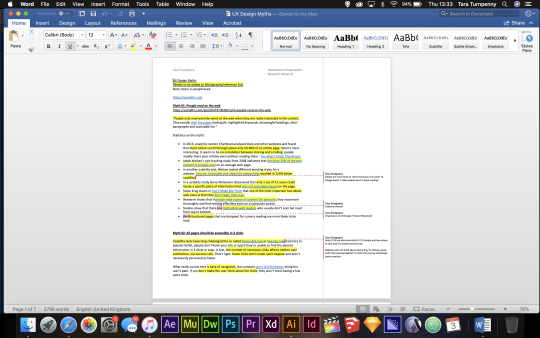
***** Attached in the blog PDF will be this word document.
Here are the main sections of the notes:
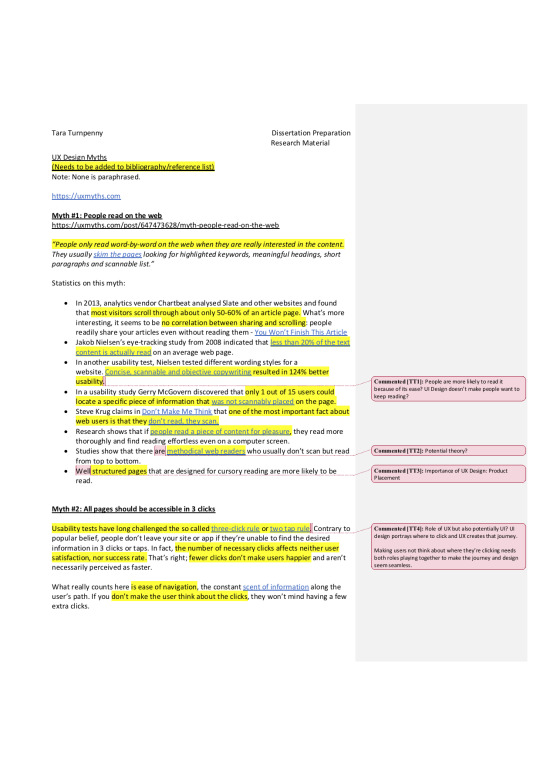
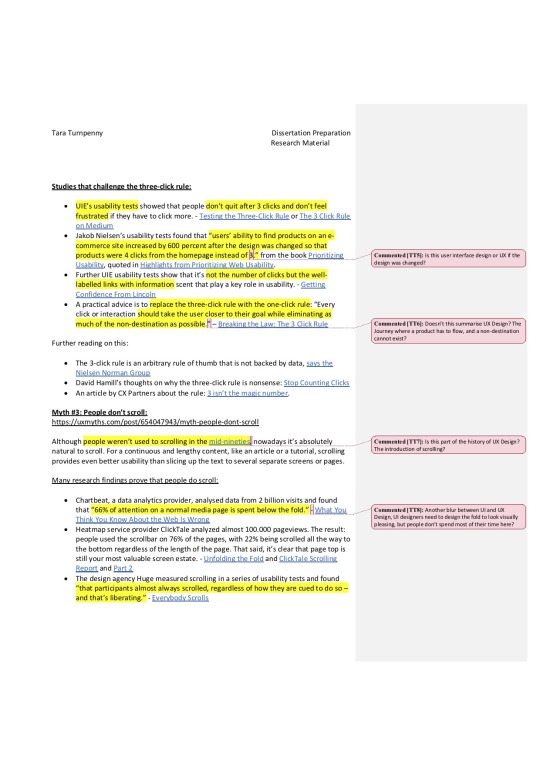
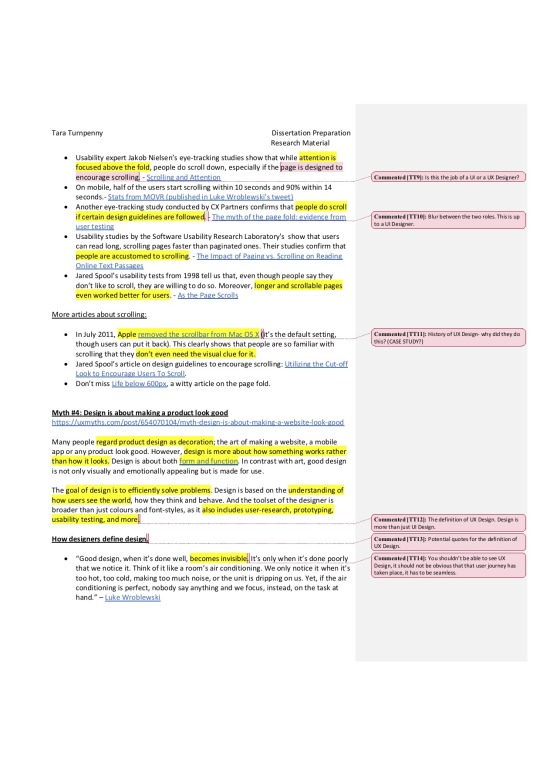
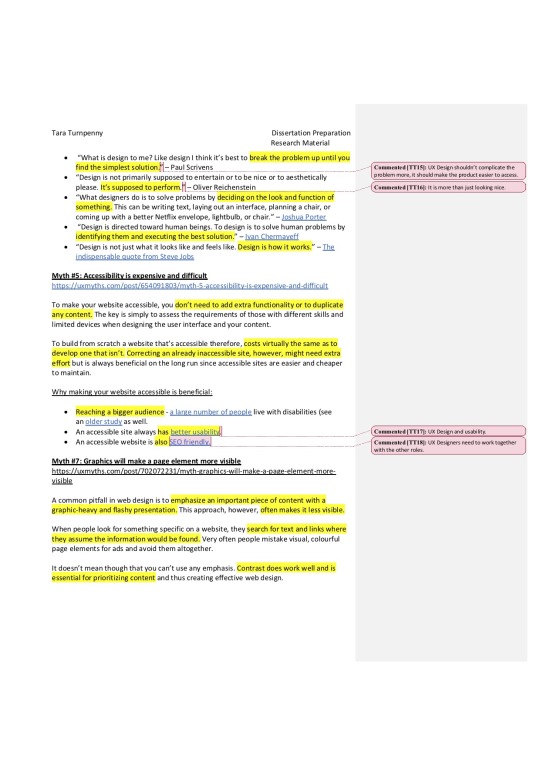
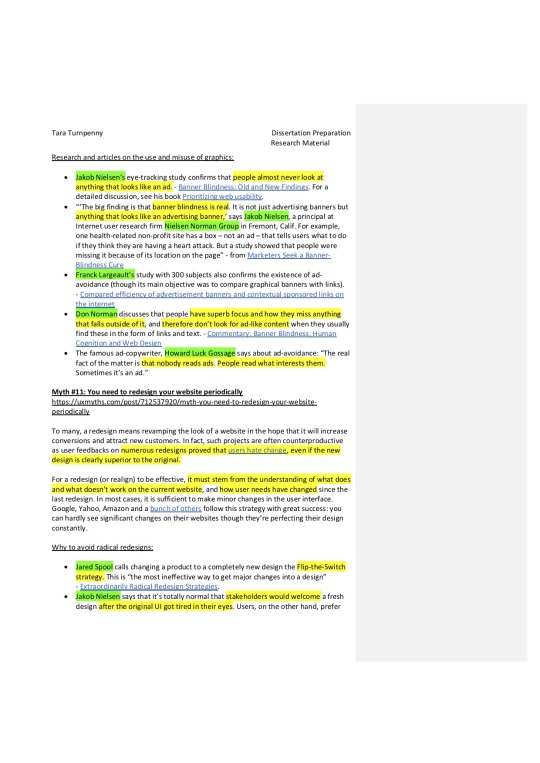

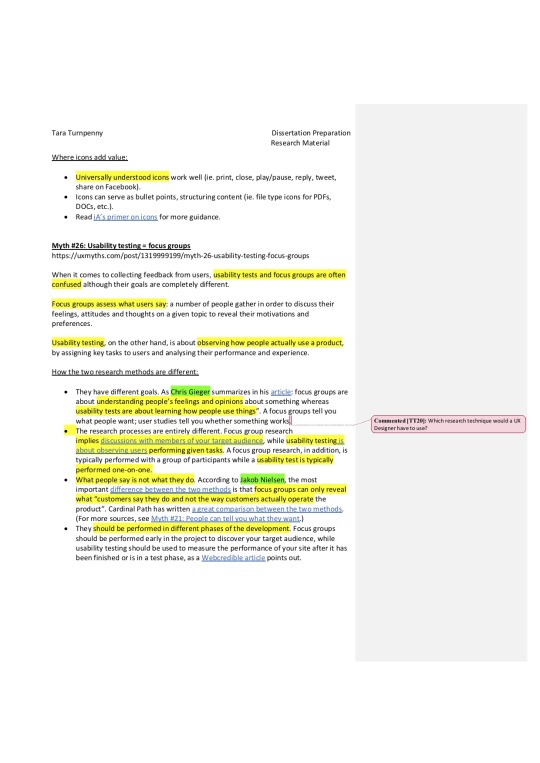
Here is the file copied and pasted from the word document without the comments in place:
UX Design Myths
(Needs to be added to bibliography/reference list)
Note: None is paraphrased.
https://uxmyths.com
Myth #1: People read on the web
Dissertation Preparation Research Material
https://uxmyths.com/post/647473628/myth-people-read-on-the-web
“People only read word-by-word on the web when they are really interested in the content.
They usually skim the pages looking for highlighted keywords, meaningful headings, short paragraphs and scannable list.”
Statistics on this myth:
In 2013, analytics vendor Chartbeat analysed Slate and other websites and found that most visitors scroll through about only 50-60% of an article page. What’s more interesting, it seems to be : people readily share your articles even without reading them - You Won’t Finish This Article.
Jakob Nielsen’s eye-tracking study from 2008 indicated that less than 20% of the text content is actually read on an average web page.
In another usability test, Nielsen tested different wording styles for a website. Concise, scannable and objective copywriting resulted in 124% better usability.
In a usability study Gerry McGovern discovered that only 1 out of 15 users could locate a specific piece of information that was not scannably placed on the page.
Steve Krug claims in Don’t Make Me Think that one of the most important fact about web users is that they don’t read, they scan.
Research shows that if people read a piece of content for pleasure, they read more thoroughly and find reading effortless even on a computer screen.
Studies show that there are methodical web readers who usually don’t scan but read from top to bottom.
Well structured pages that are designer for cursory reading are more likely to be read.
#2: All Pages should be accessible in 3 Clicks:
Usability tests have long challenged the so called three-click rule or two tap rule. Contrary to popular belief, people don’t leave your site or app if they’re unable to find the desired information in 3 clicks or taps. In fact, the number of necessary clicks affects neither user satisfaction, nor success rate.That’s right; fewer clicks don’t make users happierand aren’t necessarily perceived as faster.
What really counts here is ease of navigation, the constant scent of informationalong the user’s path. If you don’t make the user think about the clicks, they won’t mind having a few extra clicks.
Studies that challenge the three-click rule:
UIE’s usability testsshowed that people don’t quit after 3 clicks and don’t feel frustratedif they have to click more. - Testing the Three-Click Rule or The 3 Click Rule on Medium
Jakob Nielsen’s usability tests found that “users’ ability to find products on an e-commerce site increased by 600 percent after the design was changed so that products were 4 clicks from the homepage instead of 3.” from the book Prioritizing Usability, quoted in Highlights from Prioritizing Web Usability.
Further UIE usability tests show that it’s not the number of clicks but the well-labelled links with informationscent that play a key role in usability. - Getting Confidence From Lincoln
A practical advice is to replace the three-click rule with the one-click rule: “Every click or interaction should take the user closer to their goal while eliminating as much of the non-destination as possible.” – Breaking the Law: The 3 Click Rule
Further reading on this:
The 3-click rule is an arbitrary rule of thumb that is not backed by data, says the Nielsen Norman Group
David Hamill’s thoughts on why the three-click rule is nonsense: Stop Counting Clicks
An article by CX Partners about the rule: 3 isn’t the magic number.
Many research findings prove that people do scroll:
Chartbeat, a data analytics provider, analysed data from 2 billion visits and found that “66% of attention on a normal media page is spent below the fold.” What You Think You Know About the Web Is Wrong
Heatmap service provider ClickTale analyzed almost 100.000 pageviews. The result: people used the scrollbar on 76% of the pages, with 22% being scrolled all the way to the bottom regardless of the length of the page. That said, it’s clear that page top is still your most valuable screen estate. - Unfolding the Fold and ClickTale Scrolling Report and Part 2
The design agency Huge measured scrolling in a series of usability tests and found “that participants almost always scrolled, regardless of how they are cued to do so – and that’s liberating.”- Everybody Scrolls
Usability expert Jakob Nielsen’s eye-tracking studies show that while attention is focused above the fold, people do scroll down, especially if the page is designed to encourage scrolling. - Scrolling and Attention
On mobile, half of the users start scrolling within 10 seconds and 90% within 14 seconds.- Stats from MOVR (published in Luke Wroblewski’s tweet)
Another eye-tracking study conducted by CX Partners confirms that people do scroll if certain design guidelines are followed.[TT2] - The myth of the page fold: evidence from user testing
Usability studies by the Software Usability Research Laboratory’s show that users can read long, scrolling pages faster than paginated ones. Their studies confirm that people are accustomed to scrolling. - The Impact of Paging vs. Scrolling on Reading Online Text Passages
Jared Spool’s usability tests from 1998 tell us that, even though people say they don’t like to scroll, they are willing to do so. Moreover, longer and scrollable pages even worked better for users. - As the Page Scrolls
More articles about scrolling:
In July 2011, Apple removed the scrollbar from Mac OS X it’s the default setting, though users can put it back). This clearly shows that people are so familiar with scrolling that they don’t even need the visual clue for it.
Jared Spool’s article on design guidelines to encourage scrolling: Utilizing the Cut-off Look to Encourage Users To Scroll.
Don’t miss Life below 600px, a witty article on the page fold.
Myth #4: Design is about making a product look good
https://uxmyths.com/post/654070104/myth-design-is-about-making-a-website-look-good
Many people regard product design as decoration; the art of making a website, a mobile app or any product look good. However, design is more about how something works rather than how it looks.Design is about both form and function. In contrast with art, good design is not only visually and emotionally appealing but is made for use.
The goal of design is to efficiently solve problems. Design is based on the understanding of how users see the world, how they think and behave. And the toolset of the designer is broader than just colours and font-styles, as it also includes user-research, prototyping, usability testing, and more.
How designers define design.
“Good design, when it’s done well, becomes invisible.It’s only when it’s done poorly that we notice it. Think of it like a room’s air conditioning. We only notice it when it’s too hot, too cold, making too much noise, or the unit is dripping on us. Yet, if the air conditioning is perfect, nobody say anything and we focus, instead, on the task at hand.” – Luke Wroblewski
“What is design to me? Like design I think it’s best to break the problem up until you find the simplest solution.” – Paul Scrivens
“Design is not primarily supposed to entertain or to be nice or to aesthetically please. It’s supposed to perform.” – Oliver Reichenstein
“What designers do is to solve problems by deciding on the look and function of something.This can be writing text, laying out an interface, planning a chair, or coming up with a better Netflix envelope, lightbulb, or chair.” – Joshua Porter
“Design is directed toward human beings. To design is to solve human problems by identifying them and executing the best solution.” – Ivan Chermayeff
“Design is not just what it looks like and feels like. Design is how it works.” – The indispensable quote from Steve Jobs
Myth #5: Accessibility is expensive and difficult
https://uxmyths.com/post/654091803/myth-5-accessibility-is-expensive-and-difficult
To make your website accessible, you don’t need to add extra functionality or to duplicate any content.The key is simply to assess the requirements of those with different skills and limited devices when designing the user interface and your content.
To build from scratch a website that’s accessible therefore,costs virtually the same as to develop one that isn’t.Correcting an already inaccessible site, however, might need extra effortbut is always beneficial on the long run since accessible sites are easier and cheaper to maintain.
Why making your website accessible is beneficial:
Reaching a bigger audience- a large number of people live with disabilities (see an older study as well.
An accessible site always has better usability.
An accessible website is also SEO friendly.
Myth #7: Graphics will make a page element more visible
https://uxmyths.com/post/702072231/myth-graphics-will-make-a-page-element-more-visible
A common pitfall in web design is to emphasize an important piece of content with a graphic-heavy and flashy presentation.This approach, however, often makes it less visible.
When people look for something specific on a website, they search for text and links where they assume the information would be found.Very often people mistake visual, colourful page elements for ads and avoid them altogether.
It doesn’t mean though that you can’t use any emphasis. Contrast does work well and is essential for prioritizing contentand thus creating effective web design.
Research and articles on the use and misuse of graphics:
Jakob Nielsen’s eye-tracking study confirms that people almost never look at anything that looks like an ad.- Banner Blindness: Old and New Findings. For a detailed discussion, see his book Prioritising web usability.
“The big finding is that banner blindness is real. It is not just advertising banners but anything that looks like an advertising banner,’ says Jakob Nielsen, a principal at Internet user research firm Nielsen Norman Groupin Fremont, Calif. For example, one health-related non-profit site has a box – not an ad – that tells users what to do if they think they are having a heart attack. But a study showed that people were missing it because of its location on the page” - from Marketers Seek a Banner-Blindness Cure
Franck Largeault’s study with 300 subjects also confirms the existence of ad-avoidance (though its main objective was to compare graphical banners with links). - Compared efficiency of advertisement banners and contextual sponsored links on the internet
Don Norman discusses that people have superb focus and how they miss anything that falls outside of it, and therefore don’t look for ad-like content when they usually find these in the form of links and text. - Commentary: Banner Blindness, Human Cognition and Web Design
The famous ad-copywriter, Howard Luck Gossagesays about ad-avoidance: “The real fact of the matter is that nobody reads ads. People read what interests them. Sometimes it’s an ad.”
Myth #11: You need to redesign your website periodically
https://uxmyths.com/post/712537920/myth-you-need-to-redesign-your-website-periodically
To many, a redesign means revamping the look of a website in the hope that it will increase conversions and attract new customers. In fact, such projects are often counterproductive as user feedbacks on numerous redesigns proved that users hate change, even if the new design is clearly superior to the original.
For a redesign (or realign) to be effective, it must stem from the understanding of what does and what doesn’t work on the current website, and how user needs have changedsince the last redesign. In most cases, it is sufficient to make minor changes in the user interface. Google, Yahoo, Amazon and a bunch of others follow this strategy with great success: you can hardly see significant changes on their websites though they’re perfecting their design constantly.
Why to avoid radical redesigns:
Jared Spool calls changing a product to a completely new design the Flip-the-Switch strategy.This is “the most ineffective way to get major changes into a design” - Extraordinarily Radical Redesign Strategies.
Jakob Nielsen says that it’s totally normal that stakeholders would welcome a fresh design after the original UI got tired in their eyes. Users, on the other hand, prefer familiar designs as they want to locate everything easily, get things done, and leave. - Fresh vs. Familiar: How Aggressively to Redesign
·“Don’t redesign just to do something new, redesign because you have a better answer to the question.” - warns Paul Scrivens
·Jared Spool argues that all-at-once redesigns are to be avoided because they are costly and very risky. Instead, he advises an incremental approachthat is flexible to business changes. - Avoiding Redesigns (podcast)
Myth #13: Icons enhance usability
Many researchers have shown that icons are hard to memorizeand are often highly inefficient.The Microsoft Outlook toolbar is a good example: the former icon-only toolbar had poor usability and changing the icons and their positioning didn’t help much. What did help was the introduction of text labels next to the icons.It immediately fixed the usability issues and people started to use the toolbar. In another study, the team of UIE observed that people remember a button’s position instead of the graphic interpretation of the function.
In most projects, icons are very difficult to get right and need a lot of testing. For abstract things, icons rarely work well.
Research findings and articles on the usefulness of icons:
Michael Zuschlag says that “icons contrary to intuition, do not necessarily help the user find a menu item better than a text label alone(see Wiedenbeck S 1999.) The use of icons and labels in an end user application program: an empirical study of learning and retention, Behaviour & Information Technology, 18(2), p68-82).It’s not worth it.”He also discusses his views on UX Exchange.
A user’s understanding of an icon is based on previous experience.Due to the absence of a standard usage for most icons, text labels are necessary to communicate the meaning and reduce ambiguity. - Icon Usability
“When in doubt, always remember this: the best icon is a text label.”
The article The Problem With Icons provides a nice example how it’s difficult to guess an icon’s meaning without a text label next to it.
37signals applauds Apple’s MobileMe service for changing their logout icon from a power button to a “logout” label. - UI Sighting: Clear over clever on MobileMe.
Don Norman says that “Inscrutable icons litter the face of the [Apple] devices even though the research community has long demonstrated that people cannot remember the meaning of more than a small number of icons. Icon plus label is superior to icon alone or label alone. Who can remember what each icon means? Not me.
Where icons add value:
Universally understood icons work well (ie. print, close, play/pause, reply, tweet, share on Facebook).
Icons can serve as bullet points, structuring content (ie. file type icons for PDFs, DOCs, etc.).
Read iA’s primer on icons for more guidance.
Myth #26: Usability testing = focus groups
https://uxmyths.com/post/1319999199/myth-26-usability-testing-focus-groups
When it comes to collecting feedback from users, usability tests and focus groups are often confusedalthough their goals are completely different.
Focus groups assess what users say: a number of people gather in order to discuss their feelings, attitudes and thoughts on a given topic to reveal their motivations and preferences.
Usability testing, on the other hand, is about observing how people actually use a product, by assigning key tasks to users and analysing their performance and experience.
How the two research methods are different:
They have different goals. As Chris Giegersummarizes in his article: focus groups are about understanding people’s feelings and opinionsabout something whereas usability tests are about learning how people use things”. A focus groups tell you what people want; user studies tell you whether something works.[TT1]
The research processes are entirely different. Focus group research implies discussions with members of your target audience, while usability testing is about observing users performing given tasks. A focus group research, in addition, is typically performed with a group of participants while a usability test is typically performed one-on-one.
What people say is not what they do. According to Jakob Nielsen, the most important difference between the two methods is that focus groups can only reveal what “customers say they do and not the way customers actually operatethe product”. Cardinal Path has written a great comparison between the two methods. (For more sources, see Myth #21: People can tell you what they want.)
They should be performed in different phases of the development. Focus groups should be performed early in the project to discover your target audience, while usability testing should be used to measure the performance of your site after it has been finished or is in a test phase, as a Webcredible article points out.
0 notes
Text
UX Myths Research:
Over the summer I decided to carry on my research about UX Design and found various articles which could potentially help with my dissertation, if not my career post graduation.
Since I hadn't yet re-started my blog all of my note takings was on Microsoft Word. With additional notes to the side of the research.
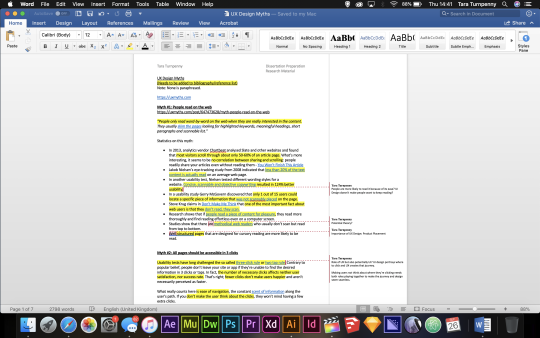
***** Attached in the blog PDF will be this word document.
Here are the main sections of the notes:
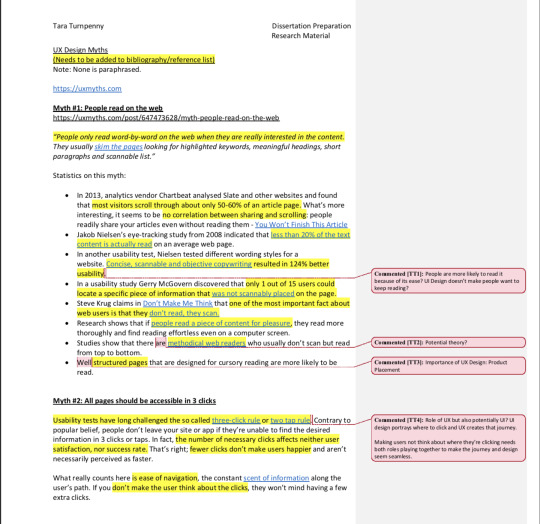
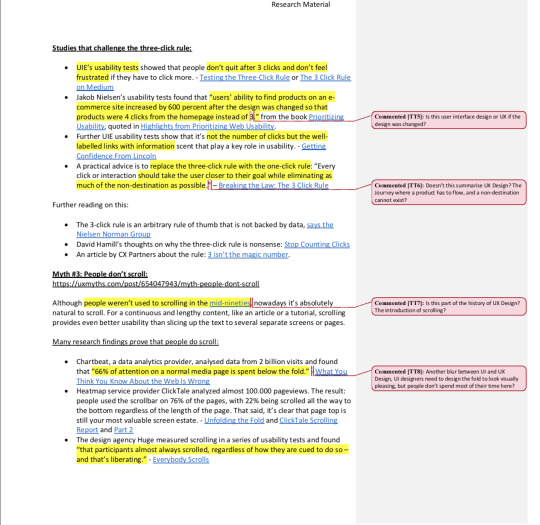
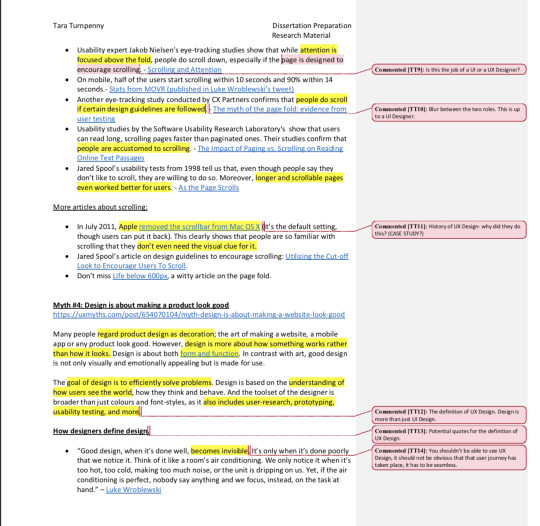

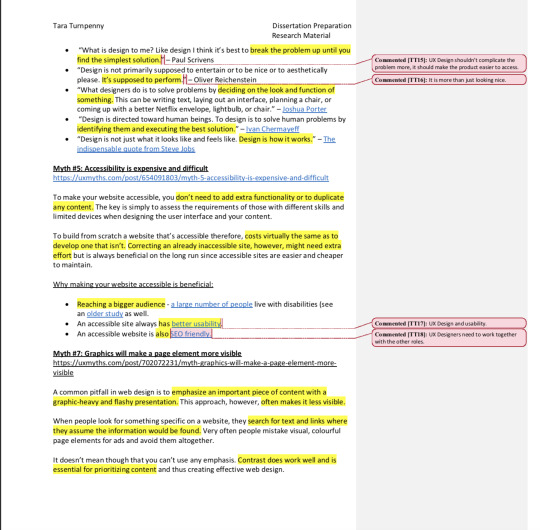
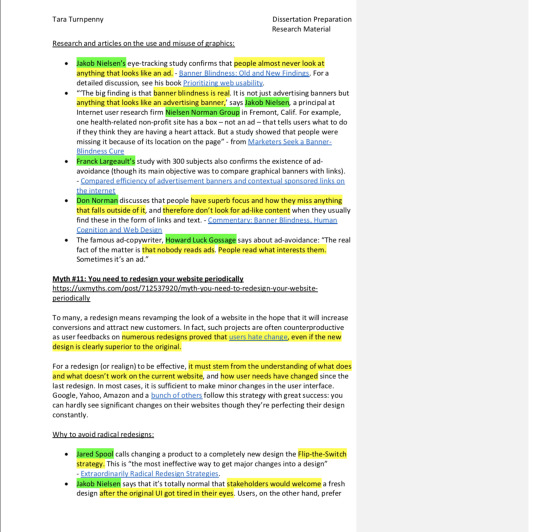
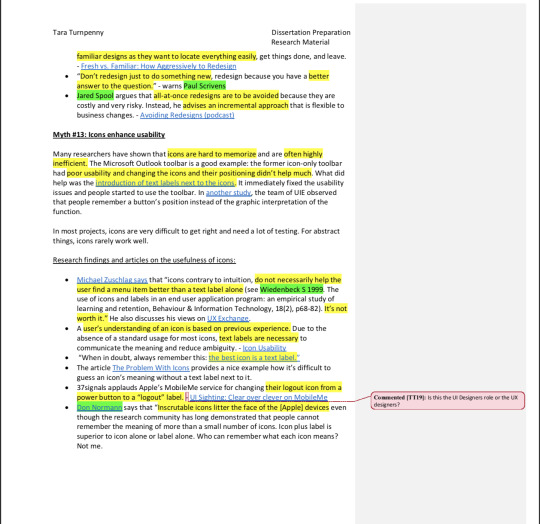
Here is the file copied and pasted from the word document without the comments in place:
UX Design Myths
(Needs to be added to bibliography/reference list)
Note: None is paraphrased.
https://uxmyths.com
Myth #1: People read on the web
Dissertation Preparation Research Material
https://uxmyths.com/post/647473628/myth-people-read-on-the-web
“People only read word-by-word on the web when they are really interested in the content.
They usually skim the pages looking for highlighted keywords, meaningful headings, short paragraphs and scannable list.”
Statistics on this myth:
In 2013, analytics vendor Chartbeat analysed Slate and other websites and found that most visitors scroll through about only 50-60% of an article page. What’s more interesting, it seems to be : people readily share your articles even without reading them - You Won’t Finish This Article.
Jakob Nielsen’s eye-tracking study from 2008 indicated that less than 20% of the text content is actually read on an average web page.
In another usability test, Nielsen tested different wording styles for a website. Concise, scannable and objective copywriting resulted in 124% better usability.
In a usability study Gerry McGovern discovered that only 1 out of 15 users could locate a specific piece of information that was not scannably placed on the page.
Steve Krug claims in Don't Make Me Think that one of the most important fact about web users is that they don't read, they scan.
Research shows that if people read a piece of content for pleasure, they read more thoroughly and find reading effortless even on a computer screen.
Studies show that there are methodical web readers who usually don’t scan but read from top to bottom.
Well structured pages that are designer for cursory reading are more likely to be read.
#2: All Pages should be accessible in 3 Clicks:
Usability tests have long challenged the so called three-click rule or two tap rule. Contrary to popular belief, people don’t leave your site or app if they’re unable to find the desired information in 3 clicks or taps. In fact, the number of necessary clicks affects neither user satisfaction, nor success rate.That’s right; fewer clicks don’t make users happierand aren’t necessarily perceived as faster.
What really counts here is ease of navigation, the constant scent of information along the user’s path. If you don’t make the user think about the clicks, they won’t mind having a few extra clicks.
Studies that challenge the three-click rule:
UIE’s usability testsshowed that people don’t quit after 3 clicks and don’t feel frustratedif they have to click more. - Testing the Three-Click Rule or The 3 Click Rule on Medium
Jakob Nielsen’s usability tests found that “users’ ability to find products on an e-commerce site increased by 600 percent after the design was changed so that products were 4 clicks from the homepage instead of 3.” from the book Prioritizing Usability, quoted in Highlights from Prioritizing Web Usability.
Further UIE usability tests show that it’s not the number of clicks but the well-labelled links with informationscent that play a key role in usability. - Getting Confidence From Lincoln
A practical advice is to replace the three-click rule with the one-click rule: “Every click or interaction should take the user closer to their goal while eliminating as much of the non-destination as possible.” – Breaking the Law: The 3 Click Rule
Further reading on this:
The 3-click rule is an arbitrary rule of thumb that is not backed by data, says the Nielsen Norman Group
David Hamill’s thoughts on why the three-click rule is nonsense: Stop Counting Clicks
An article by CX Partners about the rule: 3 isn’t the magic number.
Many research findings prove that people do scroll:
Chartbeat, a data analytics provider, analysed data from 2 billion visits and found that “66% of attention on a normal media page is spent below the fold.” What You Think You Know About the Web Is Wrong
Heatmap service provider ClickTale analyzed almost 100.000 pageviews. The result: people used the scrollbar on 76% of the pages, with 22% being scrolled all the way to the bottom regardless of the length of the page. That said, it’s clear that page top is still your most valuable screen estate. - Unfolding the Fold and ClickTale Scrolling Report and Part 2
The design agency Huge measured scrolling in a series of usability tests and found “that participants almost always scrolled, regardless of how they are cued to do so – and that’s liberating.”- Everybody Scrolls
Usability expert Jakob Nielsen’s eye-tracking studies show that while attention is focused above the fold, people do scroll down, especially if the page is designed to encourage scrolling. - Scrolling and Attention
On mobile, half of the users start scrolling within 10 seconds and 90% within 14 seconds.- Stats from MOVR (published in Luke Wroblewski’s tweet)
Another eye-tracking study conducted by CX Partners confirms that people do scroll if certain design guidelines are followed.[TT2] - The myth of the page fold: evidence from user testing
Usability studies by the Software Usability Research Laboratory's show that users can read long, scrolling pages faster than paginated ones. Their studies confirm that people are accustomed to scrolling. - The Impact of Paging vs. Scrolling on Reading Online Text Passages
Jared Spool’s usability tests from 1998 tell us that, even though people say they don’t like to scroll, they are willing to do so. Moreover, longer and scrollable pages even worked better for users. - As the Page Scrolls
More articles about scrolling:
In July 2011, Apple removed the scrollbar from Mac OS X it’s the default setting, though users can put it back). This clearly shows that people are so familiar with scrolling that they don’t even need the visual clue for it.
Jared Spool’s article on design guidelines to encourage scrolling: Utilizing the Cut-off Look to Encourage Users To Scroll.
Don’t miss Life below 600px, a witty article on the page fold.
Myth #4: Design is about making a product look good
https://uxmyths.com/post/654070104/myth-design-is-about-making-a-website-look-good
Many people regard product design as decoration; the art of making a website, a mobile app or any product look good. However, design is more about how something works rather than how it looks.Design is about both form and function. In contrast with art, good design is not only visually and emotionally appealing but is made for use.
The goal of design is to efficiently solve problems. Design is based on the understanding of how users see the world, how they think and behave. And the toolset of the designer is broader than just colours and font-styles, as it also includes user-research, prototyping, usability testing, and more.
How designers define design.
“Good design, when it’s done well, becomes invisible.It’s only when it’s done poorly that we notice it. Think of it like a room’s air conditioning. We only notice it when it’s too hot, too cold, making too much noise, or the unit is dripping on us. Yet, if the air conditioning is perfect, nobody say anything and we focus, instead, on the task at hand.” – Luke Wroblewski
“What is design to me? Like design I think it’s best to break the problem up until you find the simplest solution.” – Paul Scrivens
“Design is not primarily supposed to entertain or to be nice or to aesthetically please. It’s supposed to perform.” – Oliver Reichenstein
“What designers do is to solve problems by deciding on the look and function of something.This can be writing text, laying out an interface, planning a chair, or coming up with a better Netflix envelope, lightbulb, or chair.” – Joshua Porter
“Design is directed toward human beings. To design is to solve human problems by identifying them and executing the best solution.” – Ivan Chermayeff
“Design is not just what it looks like and feels like. Design is how it works.” – The indispensable quote from Steve Jobs
Myth #5: Accessibility is expensive and difficult
https://uxmyths.com/post/654091803/myth-5-accessibility-is-expensive-and-difficult
To make your website accessible, you don’t need to add extra functionality or to duplicate any content.The key is simply to assess the requirements of those with different skills and limited devices when designing the user interface and your content.
To build from scratch a website that’s accessible therefore,costs virtually the same as to develop one that isn’t.Correcting an already inaccessible site, however, might need extra effortbut is always beneficial on the long run since accessible sites are easier and cheaper to maintain.
Why making your website accessible is beneficial:
Reaching a bigger audience- a large number of people live with disabilities (see an older study as well.
An accessible site always has better usability.
An accessible website is also SEO friendly.
Myth #7: Graphics will make a page element more visible
https://uxmyths.com/post/702072231/myth-graphics-will-make-a-page-element-more-visible
A common pitfall in web design is to emphasize an important piece of content with a graphic-heavy and flashy presentation.This approach, however, often makes it less visible.
When people look for something specific on a website, they search for text and links where they assume the information would be found.Very often people mistake visual, colourful page elements for ads and avoid them altogether.
It doesn’t mean though that you can’t use any emphasis. Contrast does work well and is essential for prioritizing contentand thus creating effective web design.
Research and articles on the use and misuse of graphics:
Jakob Nielsen’s eye-tracking study confirms that people almost never look at anything that looks like an ad.- Banner Blindness: Old and New Findings. For a detailed discussion, see his book Prioritising web usability.
“The big finding is that banner blindness is real. It is not just advertising banners but anything that looks like an advertising banner,’ says Jakob Nielsen, a principal at Internet user research firm Nielsen Norman Groupin Fremont, Calif. For example, one health-related non-profit site has a box – not an ad – that tells users what to do if they think they are having a heart attack. But a study showed that people were missing it because of its location on the page” - from Marketers Seek a Banner-Blindness Cure
Franck Largeault’s study with 300 subjects also confirms the existence of ad-avoidance (though its main objective was to compare graphical banners with links). - Compared efficiency of advertisement banners and contextual sponsored links on the internet
Don Norman discusses that people have superb focus and how they miss anything that falls outside of it, and therefore don’t look for ad-like content when they usually find these in the form of links and text. - Commentary: Banner Blindness, Human Cognition and Web Design
The famous ad-copywriter, Howard Luck Gossagesays about ad-avoidance: “The real fact of the matter is that nobody reads ads. People read what interests them. Sometimes it’s an ad.”
Myth #11: You need to redesign your website periodically
https://uxmyths.com/post/712537920/myth-you-need-to-redesign-your-website-periodically
To many, a redesign means revamping the look of a website in the hope that it will increase conversions and attract new customers. In fact, such projects are often counterproductive as user feedbacks on numerous redesigns proved that users hate change, even if the new design is clearly superior to the original.
For a redesign (or realign) to be effective, it must stem from the understanding of what does and what doesn’t work on the current website, and how user needs have changedsince the last redesign. In most cases, it is sufficient to make minor changes in the user interface. Google, Yahoo, Amazon and a bunch of others follow this strategy with great success: you can hardly see significant changes on their websites though they’re perfecting their design constantly.
Why to avoid radical redesigns:
Jared Spool calls changing a product to a completely new design the Flip-the-Switch strategy.This is “the most ineffective way to get major changes into a design” - Extraordinarily Radical Redesign Strategies.
Jakob Nielsen says that it’s totally normal that stakeholders would welcome a fresh design after the original UI got tired in their eyes. Users, on the other hand, prefer familiar designs as they want to locate everything easily, get things done, and leave. - Fresh vs. Familiar: How Aggressively to Redesign
·“Don’t redesign just to do something new, redesign because you have a better answer to the question.” - warns Paul Scrivens
·Jared Spool argues that all-at-once redesigns are to be avoided because they are costly and very risky. Instead, he advises an incremental approachthat is flexible to business changes. - Avoiding Redesigns (podcast)
Myth #13: Icons enhance usability
Many researchers have shown that icons are hard to memorizeand are often highly inefficient.The Microsoft Outlook toolbar is a good example: the former icon-only toolbar had poor usability and changing the icons and their positioning didn’t help much. What did help was the introduction of text labels next to the icons.It immediately fixed the usability issues and people started to use the toolbar. In another study, the team of UIE observed that people remember a button’s position instead of the graphic interpretation of the function.
In most projects, icons are very difficult to get right and need a lot of testing. For abstract things, icons rarely work well.
Research findings and articles on the usefulness of icons:
Michael Zuschlag says that “icons contrary to intuition, do not necessarily help the user find a menu item better than a text label alone(see Wiedenbeck S 1999.) The use of icons and labels in an end user application program: an empirical study of learning and retention, Behaviour & Information Technology, 18(2), p68-82).It’s not worth it.”He also discusses his views on UX Exchange.
A user’s understanding of an icon is based on previous experience.Due to the absence of a standard usage for most icons, text labels are necessary to communicate the meaning and reduce ambiguity. - Icon Usability
“When in doubt, always remember this: the best icon is a text label.”
The article The Problem With Icons provides a nice example how it’s difficult to guess an icon’s meaning without a text label next to it.
37signals applauds Apple’s MobileMe service for changing their logout icon from a power button to a “logout” label. - UI Sighting: Clear over clever on MobileMe.
Don Norman says that “Inscrutable icons litter the face of the [Apple] devices even though the research community has long demonstrated that people cannot remember the meaning of more than a small number of icons. Icon plus label is superior to icon alone or label alone. Who can remember what each icon means? Not me.
Where icons add value:
Universally understood icons work well (ie. print, close, play/pause, reply, tweet, share on Facebook).
Icons can serve as bullet points, structuring content (ie. file type icons for PDFs, DOCs, etc.).
Read iA’s primer on icons for more guidance.
Myth #26: Usability testing = focus groups
https://uxmyths.com/post/1319999199/myth-26-usability-testing-focus-groups
When it comes to collecting feedback from users, usability tests and focus groups are often confusedalthough their goals are completely different.
Focus groups assess what users say: a number of people gather in order to discuss their feelings, attitudes and thoughts on a given topic to reveal their motivations and preferences.
Usability testing, on the other hand, is about observing how people actually use a product, by assigning key tasks to users and analysing their performance and experience.
How the two research methods are different:
They have different goals. As Chris Giegersummarizes in his article: focus groups are about understanding people’s feelings and opinionsabout something whereas usability tests are about learning how people use things”. A focus groups tell you what people want; user studies tell you whether something works.[TT1]
The research processes are entirely different. Focus group research implies discussions with members of your target audience, while usability testing is about observing users performing given tasks. A focus group research, in addition, is typically performed with a group of participants while a usability test is typically performed one-on-one.
What people say is not what they do. According to Jakob Nielsen, the most important difference between the two methods is that focus groups can only reveal what “customers say they do and not the way customers actually operatethe product”. Cardinal Path has written a great comparison between the two methods. (For more sources, see Myth #21: People can tell you what they want.)
They should be performed in different phases of the development. Focus groups should be performed early in the project to discover your target audience, while usability testing should be used to measure the performance of your site after it has been finished or is in a test phase, as a Webcredible article points out.
0 notes